Short on time and just wish to go straight to the 12 platforms? Go here.
Want to start selling digital products but don’t want to deal with the hassle of building a website?

You’re not alone. The digital product market is booming, expected to reach $479.33 billion by 2030, and you can grab your slice of this pie without spending thousands on web development.
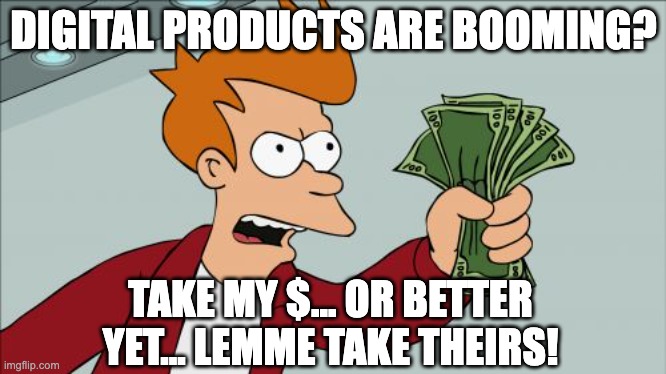
Gone are the days when a website was mandatory for selling online. Today’s digital entrepreneurs are leveraging existing platforms and marketplaces to reach customers directly, saving time and money in the process.
Why You Don’t Need a Website
Building and maintaining a website isn’t just expensive—it’s time-consuming. The average cost of a professional website ranges from $2,000 to $10,000, not including monthly maintenance fees and hosting costs.
Sure, there are DIY and affordable options available such as WordPress. But you still need to rent a server, understand how to install it (WordPress), and perform regular maintenance.
Modern platforms have eliminated the barriers to entry. They provide everything you need: hosting, payment processing, delivery systems, and even built-in audiences.
Think of it this way: instead of building a standalone store in the middle of nowhere, you’re setting up shop in a bustling marketplace where customers are already looking to buy.
Top 12 Platforms to Sell Digital Products (without a website) in 2025
I’ll show you the platforms in a table format first, followed by a more detailed explanation for each platform.
Here’s the table comparison:
| Platform | Key Features | Fees | Best For |
|---|---|---|---|
| CartMango | – Hosted checkout page ready in less than 1 minute – Free to use during beta (2025) – No commissions | – $0 platform fees – Only Stripe/PayPal processing fees apply | Creators looking for the fastest, most cost-effective way to sell digital products |
| Etsy | – Marketplace with 90M+ buyers – Discovery via “Offsite Ads” | – 6.5% transaction fee + $0.20 listing fee – 12-15% extra for Offsite Ads (optional) – Stripe/PayPal processing fees still apply | Sellers of printables and templates who want access to a large, built-in audience |
| Gumroad | – Simple setup – Marketplace discovery feature | – 10% transaction fee – Additional 30% for discovery feature (total up to 40%) – Stripe/PayPal processing fees still apply | Creators willing to pay higher fees for marketplace visibility |
| Creative Market | – Highly targeted audience of designers and creatives | – 50% commission on all sales | Designers and artists looking to sell premium digital assets |
| Instagram Shopping | – Digital storefront on Instagram profile – Tag products in posts/stories – Analytics insights | – Standard Stripe/PayPal processing fees | Visual-centric businesses aiming to leverage Instagram’s 2B+ active users |
| Facebook Marketplace | – Access to Facebook’s 2.9B monthly users – Leverage niche groups for engagement | – No platform fees; only payment processing fees | Sellers targeting niche communities or leveraging Facebook Groups |
| TikTok Shop | – Viral potential through TikTok’s algorithm – Direct shopping features | – Standard Stripe/PayPal processing fees | Creators targeting younger audiences and leveraging viral trends |
| Udemy | – Access to 75M+ students – Built-in marketing through Udemy sales | – Platform controls pricing during promotions | Educators looking for passive income from course sales |
| Skillshare | – Subscription-based model – Payment based on watch time | – No direct sales; earnings depend on minutes watched | Teachers who want consistent income without managing individual course sales |
| WhatsApp Business | – Product catalog feature – Direct communication with customers | – No platform fees; only payment processing fees | Sellers wanting a personal connection with customers |
| Telegram | – Channels for announcements – Bots for automated sales | – No platform fees; only payment processing fees | Tech-savvy sellers building niche communities |
| Discord | – Private servers with membership levels – Community-driven sales | – No platform fees; only payment processing fees | Sellers creating exclusive, community-focused experiences |
Hosted Checkout Pages
CartMango
A hosted checkout page is a simple, ready-made webpage where customers can buy your product without you needing a website. Think of it as a mini online store that’s already set up for you.
Here’s how it works: You upload your digital product (like an ebook or template) to a platform that offers hosted checkout pages, such as CartMango.
The platform creates a unique “buy link” for your product, which you can share anywhere—on social media, in emails, or even in messaging apps. When someone clicks the link, they’re taken to a secure checkout page where they can see your product details, pay for it, and instantly download it.
The best part? You don’t have to worry about technical stuff like payment processing, security, or file delivery. The platform handles all of that for you. Hosted checkout pages are perfect if you want to start selling quickly and keep things simple.
CartMango is one of the fastest ways for online business (creators) to sell their digital products. Setup takes less than 1 minute. And it’s totally free to use for 2025 (while in beta). Zero fees. Zero commissions. You still need to pay Stripe/PayPal processing fees (which you pay directly to them).
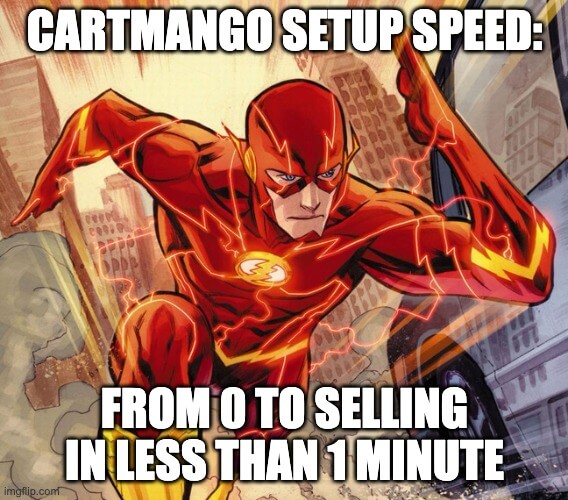
You can sign up for a free account here.
Disclaimer: If this wasn’t obvious enough, you’re on CartMango’s site 🙂
Online Marketplaces
Etsy
Etsy excels for digital printables and templates, with over 90 million active buyers. Their fees are lower than most marketplaces at just 6.5% per transaction plus a $0.20 listing fee.
When you list an item, you’ll pay a basic listing fee of $0.20. This listing lasts for 4 months, and if your item sells or expires, you’ll need to pay another $0.20 to relist it.
For every sale you make, Etsy takes a transaction fee of 6.5% of the total order amount on top of Stripe/PayPal payment processing fees. If you have any shipping and gift-wrapping costs, the 6.5% fee also apply.
Etsy has a “discovery/marketplace” feature called “Offsite Ads” where they’ll bring traffic to your store.
For Offsite Ads, you’ll need to pay extra on top of the aforementioned fees:
If you make under $10,000 in a 12-month period, you’ll pay a 15% fee on orders from offsite ads (participation is optional)
If you make $10,000 or more in a 12-month period, you’ll pay a 12% fee on orders from offsite ads (participation becomes mandatory)
–
Gumroad
Gumroad is popular but expensive. They charge 10% per transaction on top of Stripe/PayPal processing fees.
However, it could be beneficial for you because of their marketplace and discovery feature, which can help get your products in front of more potential customers. Keep in mind, though, that you’ll have to pay an ADDITIONAL 30% if you use their discovery feature, which means a total of 40% in fees.
So if your digital product is $100, Gumroad’s cut is $40.
–
Creative Market
Creative Market caters to designers and artists.
They take 50% from all sales. The pricing is even worse than Etsy and Gumroad.
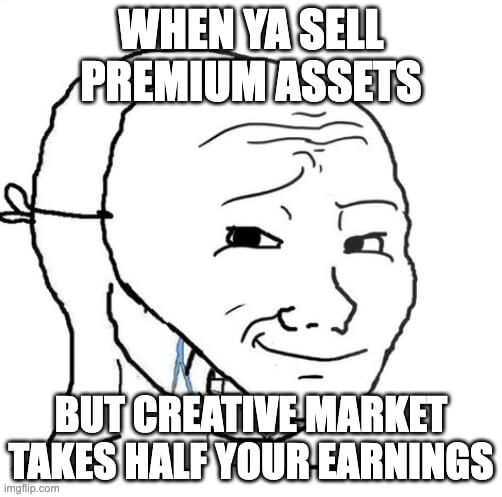
However, Creative Market stands out for its vast collection of digital goods, making it an attractive choice for creatives looking to sell digital products online.
The platform’s audience is highly targeted, consisting mainly of designers, developers, and creative professionals who are willing to pay a premium for top-notch digital assets. This means that while the fees are steep, the potential for reaching a niche market that values quality can lead to more sales and brand loyalty.
Social Media Platforms
Instagram Shopping
Instagram Shopping has transformed from a photo-sharing app to a powerful sales channel with over 2 billion monthly active users. Their checkout feature makes buying seamless for customers.
Instagram Shopping allows online businesses to create a digital storefront that showcases their products directly on their Instagram profile. This feature enables users to browse, save, and purchase products instantly without leaving the app. Businesses can tag products in their posts and stories, making it easy for potential customers to discover and buy products in just a few clicks.
Additionally, Instagram Shopping offers insights and analytics that help businesses understand their audience and optimize their marketing strategies. This data includes information on product views, clicks, and purchases, allowing sellers to tailor their content to better engage their target audience.
By leveraging Instagram’s vast user base and visual-centric platform, businesses can effectively promote their digital products and reach a wider audience, ultimately driving more sales and building stronger brand loyalty.
Source: CapitalOne Shopping
–
Facebook Marketplace
Facebook Marketplace reaches 2.9 billion monthly active users. Groups are particularly powerful here—some niche digital product groups have over 100,000 engaged members.
Source: Statista
–
TikTok Shop
TikTok’s shopping features are relatively new but promising. The platform’s algorithm can help your products go viral, with some online business owners reporting thousands in sales from single viral videos.
Source: Wall Street Journal
Learning Platforms
Udemy
Best known for its online courses, Udemy has become huge. They now have:
More than 250,000 different courses
About 75 million students taking classes
That’s a big jump from their previous numbers of 185,000 courses and 57 million students. This means teachers can make good money on the side, especially when Udemy runs sales.
Source: Prosperity
–
Skillshare
Skillshare works differently. Instead of selling courses one by one, they:
Charge students a monthly subscription fee
Pay teachers based on how many minutes students spend watching their videos
The best teachers on Skillshare can make over $100,000 a year. This is great for teachers who don’t want to worry about selling courses themselves.
Source: Skillshare
Selling Digital Downloads via Messaging Apps
Messaging apps like WhatsApp, Telegram, and Discord have become increasingly popular platforms for selling digital products. These apps offer a direct line to potential customers, allowing for personalized interactions and instant communication. Here’s how you can leverage them to sell your digital goods:
Use WhatsApp Business – it’s like regular WhatsApp but with extra features for sellers
You can set up automatic replies and show your products in a catalog
Share your digital products right in the chat
Telegram
Create a channel to announce new products and deals
Make groups where customers can chat and get help
Use bots (like digital assistants) to handle sales and questions automatically
Discord
Great for building a community around your products
Make your own server (like a digital shop)
Control who sees what with different membership levels
These apps help you build better relationships with customers because you can chat with them directly. Don’t spam people though, keep it friendly and helpful.
5 Steps to Getting Started
Step 1: Identify Your Product
The most successful digital products solve specific problems. Ebooks, templates, courses, and software tools are consistently top sellers.
Consider your expertise and what you can teach others. The best products often come from your own experience solving problems.
Look for gaps in the market by reading customer reviews on existing products in your niche. What are people asking for that isn’t available yet?
Step 2: Choose the Right Platform
Selecting the right platform depends heavily on your product type and target audience. We’ve covered the different platforms above. Review them and choose one that fits your needs.
Step 3: Create High-Quality Listings
Your product listing is your storefront. Make it count.
Write compelling descriptions that focus on benefits, not just features. Instead of saying “50-page ebook,” say “Learn to master digital marketing in 2 hours with this step-by-step guide.”
Include social proof whenever possible. Customer testimonials, usage statistics, or even “as featured in” badges can boost conversion rates.
Step 4: Promote Your Products
The “build it and they will come” is a myth. You need a solid promotion strategy.
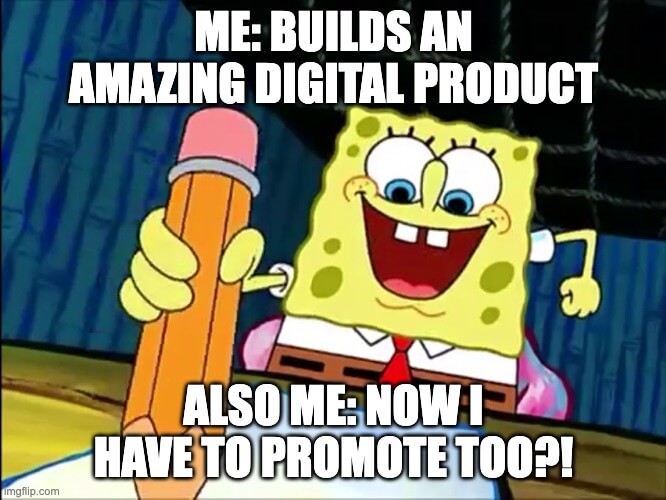
Start with the platform’s built-in promotion tools. Many marketplaces offer internal advertising options that can put your product in front of ready-to-buy customers.
Cross-promote on social media platforms where your target audience spends time. Remember, different platforms serve different purposes:
Instagram: Perfect for visual products and behind-the-scenes content
LinkedIn: Ideal for professional development products
TikTok: Great for quick tutorials and product demonstrations
X/Twitter: Excellent for building authority and sharing quick tips
Step 5: Manage Payments and Delivery
Most platforms handle payment processing and delivery automatically, but you should still understand how it works. Set up multiple payment options to accommodate different customer preferences.
Consider offering various pricing tiers or bundles. Some customers might want a basic version, while others are willing to pay more for additional features or support.
Automate as much as possible. Set up email sequences to welcome new customers, provide download instructions, and request reviews.
Marketing Strategies Without a Website
Social Media Marketing
Create content that provides value before asking for a sale. The 80/20 rule works well here: 80% valuable content, 20% promotional.
Use platform-specific features to your advantage. Instagram Stories with swipe-up links (for accounts with 10k+ followers) can drive direct sales, while Pinterest’s rich pins can showcase your products organically.
Leverage trending hashtags and topics in your niche, but make sure they’re relevant to your product. Random hashtag stuffing can hurt more than help.
Email Marketing
Start building your email list immediately. Offer a free “lead magnet” related to your paid product to attract subscribers.
Use email marketing tools like BirdSend to automate your email sequences and send traffic to your sales page or checkout page.
Segment your email list based on customer behavior and interests. This allows you to send more targeted promotions and increase conversion rates.
Collaborations and Partnerships
Partner with complementary creators rather than direct competitors. If you sell graphic design templates, collaborate with someone who sells social media marketing courses.
Reach out to micro-influencers in your niche. They often have highly engaged audiences and charge reasonable rates for promotions.
Consider setting up an affiliate program too so people can promote you in exchange for a commission.
Paid Advertising
Start small with paid ads. Test different platforms with a modest budget ($5-10 per day) to see what works best for your product.
Focus on retargeting ads initially. These target people who’ve already shown interest in your product and typically have higher conversion rates.
Use platform-specific ad formats effectively:
Facebook/Instagram: Carousel ads work well for showcasing multiple product features
TikTok: In-feed ads that match organic content style
Pinterest: Promoted pins for long-term visibility
3 Tips for Success
1/ Building Trust
Display customer reviews prominently. Happy customers are your best salespeople.
Create short video demonstrations or tutorials showing your product in action. This helps potential buyers understand exactly what they’re getting.
Respond promptly to customer questions and concerns. Good customer service can turn one-time buyers into repeat customers.
Here’s a 2-min video on how to get people to trust you:
2/ Pricing Strategies
Research competitor pricing but don’t automatically undercut them. Price based on value, not just market rates.
Offer strategic discounts and bundles. Limited-time offers can create urgency and drive sales, but don’t discount so often that customers always wait for sales.
Consider implementing tiered pricing:
Basic version for budget-conscious customers
Standard version with core features
Premium version with additional benefits
3/ Analytics and Optimization
Track key metrics across all platforms:
Conversion rates
Average order value
Customer acquisition cost
Return customer rate
Use this data to optimize your listings and marketing strategies. What works on one platform might not work on another.
Test different elements of your product listings:
Product titles
Images and thumbnails
Pricing points
Description formats
Common Challenges and Solutions
Managing Multiple Platforms
Use tools like Buffer or Hootsuite to schedule social media posts across platforms. This saves time and maintains consistent presence.
Create a content calendar to plan your marketing activities. This helps prevent overwhelm and ensures regular engagement with your audience.
Consider automating routine tasks using tools like Zapier to connect different platforms and streamline workflows.
Dealing with Competition
Focus on your unique value proposition. What makes your digital product different or better than alternatives?
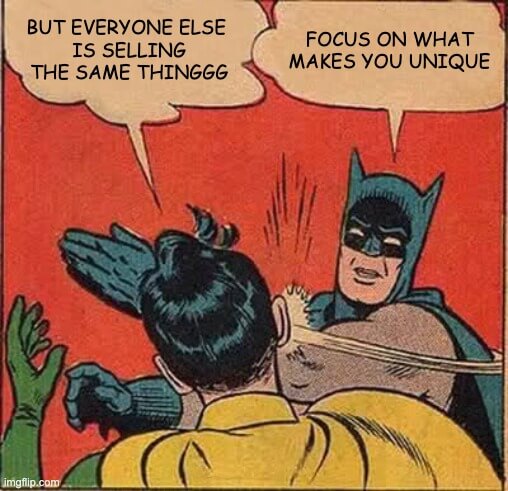
Keep improving your product based on customer feedback. Regular updates and additions can help maintain a competitive edge.
Build a community around your product. Engaged customers are less likely to switch to competitors, even if they offer lower prices.
What Next?
1/ Choose the right platforms that fits your business needs
2/ Create useful, valuable digital products
3/ Maintain consistent marketing efforts
The answer to the question: “how to sell digital products without a website” lies in the 3 key points above.
Start with 1 platform and product, then expand as you learn what works for your specific niche and audience. The beauty of digital products is their scalability—once created, they can generate income indefinitely.
Remember that building a successful digital product business takes time. Focus on providing value and building relationships with your customers, and the sales will follow.
Related Reading
- Gumroad vs Sellfy: The Vendor Lock-in Cage (2025)
- Gumroad vs Payhip: The Hidden Trap for Creators (2025)
- ThriveCart vs SamCart – The Subscription Hostage Trap (2025)
- 8 ThriveCart Alternatives & The Lifetime Pricing Paradox (2025)
- 8 SamCart alternatives + Subscription hostage (2025)
- The GENTLE Method: Soft marketing for creators
- How Far in Advance Should You Promote a Webinar?
- The SAVINGS Method: The Productivity Improvement Plan for Creators
- 9 Questions to Ask: How to Hire a Digital Marketing Agency
- Decision That Costs Millions? Marketing Funnel vs Customer Journey
